home//my emails//my blog//my photos at pbase//my pictures at SerenityPhotography.co.uk//my stock images//about me
previous//next
Journey to Spiti
3rd July 2010, Mandala Hotel, Kaza, SpitiI am utterly exhausted, drained to the core, battered and bruised . . . and I have just had one of the best experiences of my life. If you want to see some of the most spectacular, dramatic scenery you are ever likely to see from the relative comfort of a jeep, then come to Spiti Valley in Himachel Pradesh.
As you know from my last email, I was a tad apprehensive about the journey here from Manali . . . and equally perturbed at having to meet my jeep at 0430. Imagine my dismay then when I received a message via my guesthouse that I now had to catch the jeep at 0400! I was also rather dubious - when I'd first enquired about jeeps to Kaza I was told the pick-up time was 0500, then when I booked I was told to be there (there being a cafe at the end of the lane where I'm staying, just a five minute walk, thankfully) at 0430 - and now the time had come forward again to four o'clock. I suspected I wouldn't see hide nor hair of the jeep until five . . . but obviously I couldn't take that risk, so I grudgingly changed my alarm to 0330, and asked my reliable father to give me a phone call around the same time, just to be sure.
Surprisingly I felt quite alert when I woke up. I had a brief chat with my parents, then packed up my few remaining bits and plodded off along the narrow dirt-path to the main road, and the cafe where I'd be picked up. The guys there were just waking up (no doubt assisted by my dumping my pack onto one of their chairs). The owner was surprised I was there so early as, he said, the jeeps for Spiti don't leave until five or six o'clock. Sure enough, I sat there for over an hour before my driver arrived. Prior to that an American couple turned up, also going to Spiti, but when my jeep turned up they were not booked on it. We set off, and headed into the new town, where we halted for over half an hour. Whilst there, a posh looking minibus pulled up with the American couple on board. I chatted to them, feeling envious as I looked at the legroom they had - and annoyed when I found out that they'd paid less than I had for such luxury.
My jeep, which smelt a bit, was much more cramped. On the way down from Old Manali the driver told me it took eight passengers, two in the front alongside him, four in the row behind, and two people in seats facing each other in the rear. I'd already been prepared for the luggage going on the roof, as the travel agent had told me. Fortunately though, our luggage remained in the rear section as we had only six passengers - well, seven if you include a sweet little tot of a lad, with a Tibetan-looking face. He was travelling with his mother, and we also had a monk on board, and a young girl originally from Manali, but studying in Delhi. She was travelling to the region, accompanied by a male relative, to do research on some villages in the Pin Valley, a couple of hours away from Kaza. She was a tiny girl, which was lucky, as we were sharing the seat in the front. Predictably though, I hogged the window seat, for all those fabulous photo opportunities - and boy, were they some. For a scenery junkie like me, this was a blissful journey.
The driver, Papu, bore a strong resemblance to my friend Syko (to my eyes, at least; an Indian version of him, obviously). While this didn't fill me with confidence at his driving abilities, it did make me warm to him. He looked much younger than his 32 years, and at first I was dubious as to whether he'd be up to the job - this was also partly due to him clipping the wing mirror of a parked car within five minutes of picking me up. It didn't take long for me to be satisfied that I had nothing to worry about in that department. He was an excellent driver, his concentration fully focussed on the road the whole way (well, except when he was spitting paan out of the window, but he didn't do that very often, and always waited for a straight section of road and slowed down before he did). He didn't even play ridiculously loud Indian music, or honk his horn more than was necessary - and when you're overtaking a crawling truck on a tricky, narrow section approaching a hairpin bend, honking is most definitely necessary. I was most impressed with his driving skills, and soon relaxed - after the first ten minutes I don't think I felt nervous at all - and I'm a dreadful passenger as a general rule.
By the time we finally got away at around half past five, I was feeling as excited as a child on Christmas Eve, and really looking forward to my adventure. We began by following the course of the Beas River north, and then started climbing towards the Rhotang Pass, which peaks at almost 4,000 metres, and is where many Indians get their first taste of snow. The road was lined with small stalls renting flea-bitten ski-suits and fur coats. There was nice tarmac for some of the way, which lulled me into a false sense of security; it didn't last long. Road improvements resulted in temporary road wrecking, and we zigzagged up the to the mountain. The green, crumpled looking mountains gave way to more serious, rugged ones, and we began to pass our first roadside snow - although it took a while for me to recognise it, as it was stained black by exhaust fumes. The going was slow over the rough road, and at one stage we were overtaken by a huge group of horses . . . although to be fair they were being driven straight up the mountain, where as we were following the hairpin bends.
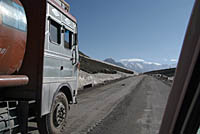
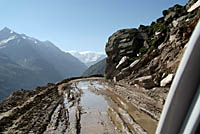
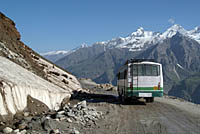
A couple of hours into the journey, and we'd topped the pass and started winding our way down the mountain on the other side until we got to Gramphu. From there we branched off from the more-travelled road to Leh, and turned east, following the Chandra River through the Lahaul Valley, where the mountains were a lush green. At places the snow was piled up either side of the road where it had drifted twenty feet high. At other places frozen rivers had formed mini glaciers - but it was all melting now, hence the road often resembled a river. I surprised myself by loving the bumpy ride, and was not at all afraid of the drops at the side of the road - in fact on more than one occasion I caught myself wishing we could get a bit closer to the edge for a better picture.
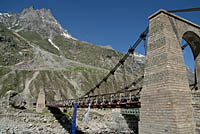
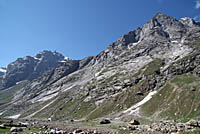
Half an hour into the Lahaul Valley we stopped at Chattru, a collection of simple dhabbas next to a bridge. I had a tasty parantha and two cups of heavily gingered chai for Rs25 (about 30p) - my best value meal! A couple more jeeps pulled up, including one with a middle-aged western woman in it. I couldn't help myself enthusing about the glorious scenery - I felt effervescent with happiness. The lady, who was French, correctly surmised that this was my first visit to Spiti; she had been a number of times, and told me how lucky I was to have clear skies, as often the clouds come right down (which makes sense, as the region is a couple of kilometres high). This news further increased my joy; I felt so lucky to be experiencing nature's glory at its brightest and best. Before we continued I hunted through my backpack for extra xD cards for my camera - it was naive of me to think that 4Gb would suffice for the journey. Nearly seven gigs later, I'd taken over 1,500 pictures - which I think may be a new personal record! Don't worry, I won't make you look at them all (you can see a few of them here), but hopefully I've got some nice shots to submit to my stock company . . . if I keep on plugging, I'll get to be a proper professional photographer one day.
We journeyed on, the road unpaved but relatively smooth following the course of the Chandra River, steep mountains on either side, waterfalls gushing from up high, where the winter's snow was finally melting, turning the rocks beneath shiny and black. Beneath the craggy mountaintops, the valley looked lush and green, with grass and wildflowers growing, adding splashes of colour to the grey countryside. The peaks looked jagged and sharp, but the rocks near the bottom were rounded and smooth, worn down by centuries of weather. Huge boulders had rolled down in places, balancing near to the road. At one point I saw some yaks grazing on the grass in the valley, which made me smile even more. The scale of the place was astounding. Further on, in a more barren section, our progress was halted by hundreds of sheep that were being moved through the valley by a number of herders. Just ahead of them were some packhorses, driven by three woolly dogs and some men on foot, with large bundles of sticks tied to their backs. After a while we left the river and started up another mountain pass - Kunzum La, which is over 4500 metres high. The windscreen had got a bit grubby, so Papu pulled up to a snow drift, and threw some snow on the glass, washing it clean with the wipers - no need for washer fluid here! We had a brief stop at the Buddhist stupas at the top, with prayer flags flapping in the breeze. The air was very chilled here, although the sun was simultaneously hot; it's an odd sensation.
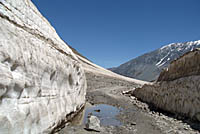
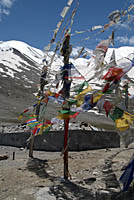
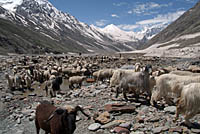
At half past twelve we reached Losar, where I had to show my passport, and ate lunch in a quaint little place. When I got back in the jeep afterwards I realised just how achy I was - bumpy roads really do take it out of you. The great scenery continued though, so I soon forgot my woes. We were now following the course of the Spiti River, and the only green was close to the water. The mountains were rugged and bare, and the rock more brown than the grey of Lahaul Valley. Much of it had been broken down by the elements into shale, and slid from the mountain tops, reminding me of those sand pictures you get, where the multicoloured sand creates a different image each time you turn them upside down. Every so often we would come across a small settlement of boxy houses. At places strange shapes emerged from the shale, where erosion had worked at different rates - similar to the "fairy castles" of Capadoccia. It looked like a lost city was being uncovered from beneath the land. The scenery mellowed a little; the strip of green became wider, and electricity wires ran between the small villages (boo - it's not that I want to deprive these people from mod cons, the wires are just so unsightly).
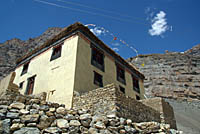
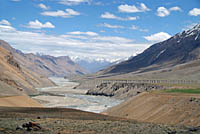
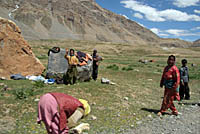
Nearly ten hours into the journey, and the distance to Kaza was down to single figures. We'd met few vehicles along the way, most of those trucks, buses, or share jeeps going the opposite way, plus a few motorcycles and the occasional hardy cyclist. Surprisingly there were a couple of regular cars too - I think of all forms of transport over the rough terrain, that's probably the one I'd be most worried about. The region really is remote, and the road I travelled on is only passable between July and October. I'd liked HP's little safety signs along the way - "no hurry, no worry", "safety saves", "life is short, don't shorten it further" "Alert Avoid Accident". As we drew near Kaza I was pleasantly surprised. I'd heard it said that Kaza was an ugly little town - although quite how anything that sits amongst such majestic beauty can possibly be described as ugly is beyond me - unless it is in comparison to it's surroundings. Papu recommended the Mandala Hotel, which was just a short stagger away (and I later realised was the place I'd selected from my guide book, although that information had been shaken out of my brain during the bumpy drive).
My injuries include a bruised left shoulder from banging against the window frame on the bumpy roads (my other shoulder's a bit tender too, as the girl next to me headbutted it each time she nodded off); swelling and friction burns on the inside of my left arm where I tried to clamp onto the door to steady myself taking pictures; a sore and watering eye where my camera kept slamming into it as we lurched along the rocky road; a painful nose that feels like it's been squashed all over my face (the camera again); what I like to term "photographers' fingers" - stiff joints in my right hand from holding the camera; and a case of sunburn - the thinner air increases the tendency to burn (plus we're a couple of km nearer the sun!). I've also got a headache, but whether this is to do with the amount of times my head slammed into the window frame, or AMS, I'm not sure - probably a bit of both. And taking all that into account, I've had a fabulous day, and would do it again in a heartbeat. In fact I'm even considering taking the "sublime but scary" road and looping down through Kinnaur - if the scenery's half as good as what I saw today, it'd be worth the scare!
A few words on AMS - Acute Mountain Sickness, or altitude sickness.
When I'd started looking into the whole AMS/altitude sickness business I became a little concerned that I would be at risk in travelling to Kaza. On the whole, altitude sickness doesn't kick in until you get above 2,500 metres, and is much more likely to make an appearance at an altitude of 3,000 metres or higher. The general advice is to have a night at an interim altitude before you reach 3,000 metres, and from then on ascend no more than 300 metres a day; Kaza sits at an altitude of 3,600 metres. I'd spent a week at Manali, just over 2,000m, so that must have helped - some people fly from Delhi to Leh, which is roughly the same altitude as here . . . admittedly a lot of those people will then suffer with AMS.
AMS - Acute Mountain Sickness - is caused by lack of oxygen to the body - there is less pressure at altitude, and so less oxygen each breath of air. This can have serious effects on your brain or your lungs, and potentially result in death. Mild AMS produces symptoms of nausea, headaches, mental confusion and co-ordination issues - those suffering act as if intoxicated. If mild symptoms occur and the correct action is taken - resting at that or a lower altitude and drinking plenty of water - no worries, you're body will adjust to surviving on less oxygen. If the symptoms are ignored and sufferers continue to ascend, things can take a nasty turn for the worse. Curiously a symptom of AMS (which consequently becomes a cause) is being in denial that you have it. Which made me wonder - so if I think I have AMS, I probably haven't, and if I think I'm okay, I probably am suffering with altitude sickness. Bizarre.
AMS aside, there are certain changes that the body goes through in adjusting to the lower oxygen content in the air, such as hyperventilating and shortness of breath. Another common but normal and non-dangerous change that can happen at altitude is known as Cheyne-Stokes Respirations, which can often occur while you're sleeping. It's a disturbed breathing pattern, where you go from shallow breathing to big sighs to stopping breathing altogether, or holding your breath. Apparently the breath holding can go on for up to fifteen seconds, and is then followed by a short burst of panting to make up for this. The article I read said that this can prove most disconcerting both for the person involved, and anyone sharing a room/tent with them, as they think that they've stopped breathing - it would put the willies up you if you weren't expecting it.
There are a couple of different tablets you can get to treat/prevent AMS, although one in particular is controversial. That is Dexamethasone, which treats the symptoms of AMS, and can mask them, so that people don't realise they have mild altitude sickness, continue climbing and end up with severe consequences. I opted for the other medication, Acetazolamide, which actually helps you to acclimatize quicker, by allowing you to breathe faster, and making you piss out bicarbonate, which makes your blood more acidic - a good thing, apparently, when you're trying to acclimatize. It can also help you sleep better, as disturbed sleep patterns can occur at altitude (or indeed anywhere, for me). There are a few side effects, like tingly hands, food tasting strange and peeing excessively, but it seems to be doing the trick so far.
Get a FREE guestbook here!
 Visit SerenityPhotography.co.uk, where you can buy beautiful pictures from around the world . . . all taken by yours truly! |